Bad Tea in Berlin (Part Two)
Bad tea. Berlin is full of it. And it’s time to point fingers at those bad beverages prepared badly for bad prices. To read my rant about why it’s so hard to find a good cup of tea in Berlin––with details on why my grandmother had two kettles and how tea ‘dust’ looks like dirt–– please link to my first post on this subject. There, I also reflect on why British World War Two strategy concerned itself with the Germans’ bad tea-making skills. Seriously.
I should add that since I wrote my first post, I’ve come to the conclusion that there are after all brave souls in Germany trying to make a good cup. My visit to Tee Tea Thé in Schoeneberg convinced me of that.
Herr Scholz, the owner, had also some instructive things to say about tea culture in Germany. He explained that tea is simply not part of German beverage culture. Tea is cheaper than coffee, so was thought of historically as the poor-man’s beverage, consumed only in a relatively impoverished region, with maritime links: Friesland.
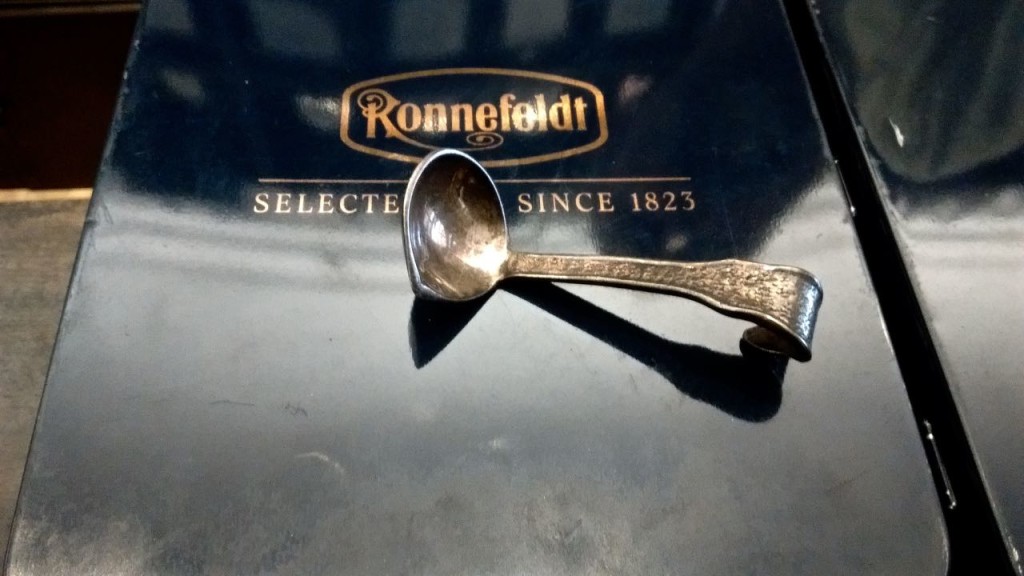
There, they developed their own Ostfriesicher Tee culture. The preparation of this tea, composed of at least 50% Assam Broken Tea (BOP), is quite peculiar: one puts a very large rock of sugar (Kluntje) at the bottom of a cup, then with a special spoon (Rohmlepel) one drops globes of cream without stirring too much––this creates a cloud effect. It’s something worth trying at Tee Tea Thé; they’ll even let you use the Rohmlepel if you ask.
Herr Scholz explained that an important reason why Germany does not have a strong tea culture is that it never had many overseas colonies, where tea was produced. Berlin, more specifically, was always a workers’ city, with little time for intricate foreign tastes and habits––it was all meat and potatoes and a strong cup of coffee. The coffee revolution in Berlin builds on a beverage already consumed by Berliners, while a tea revolution would have no foundation. Only in the 20s, he explained, was there something of a tea fad. I found some related information about tea-dances in the fancy hotels––the Adlon for example. Maybe we can hope for a Weimar Renaissance? But did the tea dances have good tea? Did they know how to make it? Maybe the craft was even lost on Berliners in the 20s.
Let me explain something at this juncture: making good tea is a pragmatic affair. One is not dealing with ossified orthodoxies, as when you tell an Italian you’d like to add garlic to an Amatriciana (which tastes good with garlic––but this innovation is stubbornly, even fascistically, ‘vietato’). No, here we are talking simply about good ingredients and best methods for infusion based on utility.
I really don’t think I’m being that fussy when I rate a cup of tea on: 1) Tea quality: that tea is actually leaf-tea. What I mean is that you can see that whole and broken tea is being used, rather than processed leftovers ground into ‘dust’. You can make an imperfect comparison to coffee from beans as opposed to coffee from instant. I also would like a decent selection of black teas that goes beyond the standard ‘Earl Grey or Darjeeling’. 2) Tea delivery: tea in a paper teabag makes your tea taste like bleach. I’m for a cloth or metal strainer (or some other kind of filter that doesn’t taste of paper). 3) Tea that is served properly, in a separate pot with teacup, or failing this simple step––and here I begin to compromise––in a tall mug or cup, rather than a shallow coffee cup. 4) that there is proper infusion of the tea: that water is of the right temperature, that hot water is added to tea (not tea to water), and, finally, 4) if one has milk, that good quality milk is served cold and on the side (not hot, and not added immediately to the tea to impede infusion), and that milk is not served with a tea that cannot stand up to it.
I visited a random handful of local Berlin establishments serving (but not necessarily specialising in) tea, to test, in practice, what obscenities are being visited on the noble beverage in the German capital. The results of the investigation are five instructive examples, from very good to bad, from excellent preparation to liquid crime.
1. NOBLE CUP
Now that I have finished wiping the tears from my eyes, I can tell you about my experience at Tee Tea Thé, that noble specialty teashop and tearoom in Schoeneberg. I sat down and ordered an Assam (3,80 EUR at teatime, 4,30 EUR other times, for a three-cup pot). I was suspicious because I saw low-quality teabags on the shelf when I walked in. But the kind server turns the page of the menu for me and there I see 240 different kinds of tea from which to choose, and two pages of Assam. I blink. I order a Mangalam. The grade is indicated (FTGFOP1) and also the flush (Summer). But how will it arrive? In a proper pot, of course, properly warmed, with a porcelain teacup, cold fresh milk served separately, even a timer counting down three minutes (although since this is premium full-leaf Assam, I think it needs a little longer, so the timer is a little off). The tea itself was tippy, malty, wonderful, and it was mild enough (a proper afternoon tea) that I hated to add milk to it. The candle fluttered, and for a moment I almost saw my grandmother’s hand on the pot, and a voice telling me I should have more.
2. WORTHY CUP

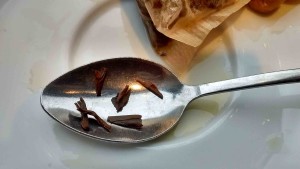
I expected somehow, walking into Café 9, a temple for hipster coffee in the Kreuzberg Markthalle 9, that they would have terrible tea. All that attention to weighing beans and calibrating water temperature for coffee must drain mental energy from tea tasking. Especially, since the rest of that energy is spent on selecting funky eyewear and chiselling facial hair. I’m not optimistic when presented with a tall glass cup of Assam tea (2,00 EUR, cheaper than tea elsewhere), with a paper filter floating in it. And there was only a few choices with generic names: Earl Grey, Darjeeling… Yet. yet. The water is properly hot. And, tearing open the paper, you can see broken tea leaves (we soon learn are from a local tea specialty shop). Miracle: actual leaves! BOP! Wonder of wonders! A purist would be disappointed there’s no tea pot instead of the tall glass cup. But let’s look on the bright side: they’ve added boiling water to the tea, not teabag to water. The milk is served separately, and is cold. All this yielded a slightly astringent brew, but since this is fine tea, this point is a matter of taste. Thank you coffee people who kind of care about tea.
3. COMPROMISED CUP
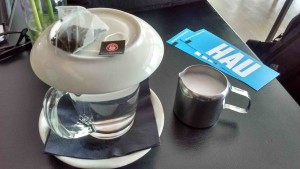
At WAU, the café of the theatre HAU near Möckernbrücke, for 2,50 EUR you have a choice of Sencha or Earl Grey, which is already a problem. There is no unflavoured black tea. Milk is served hot. Teabag is not in glass. Tea is in Teekane pyramid: at least it has no paper, but a synthetic net. The insides are a regrettable mix of Fannings and Dust (Teekanne extol on their website that they use the ‘finest tea’ and that fannings and dust are even desirable, because they produce more tea and make a stronger tea! A sophistic way of saying quantity is better than quality). Nonetheless, the fact that the bag, when opened up, reveals identifiable pieces of tea inside it, means that the brew is also not half-bad. But as Royksopp says, 49% is only half of nothing.
4. LIQUID MISDEMEANOR
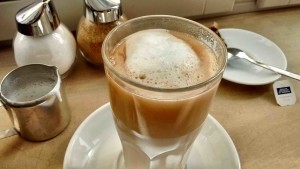

D’espresso, a bright corner coffee shop in Kreuzberg, is the daytime operation of the wonderful cocktail bar RIAS, with their dark wood interior. Will their subtle mixology skills be applied to a cuppa of tea? I ask for a black tea, and am met with the answer ‘Earl Grey or Darjeeling or English Breakfast’. Oh dear. Below the counter I see a boxed range of 22 kinds of Althaus brand ‘deli packs’––most are infusions. . The tea is presented in a tall glass, properly hot, paper teabag already in, an improvement on the shallow coffee cup, which is sometimes offered here. And the milk is offered on the side, hurrah. But things go wrong: the milk is scalding hot, heated by the espresso frother, which leaves an unwanted tea-o-cino head on the infusion. Under this is what proves to be an astringent dirty water brew that tastes like sock water. We know why when open the teabag for inspection: there is what looks like dirt inside, because Althaus apparently uses lowest quality dust with some fannings: the kind I imagine found simply at the bottom of the crate of Indian tea. And in India no one wants to lick the ground.
5. LIQUID CRIME
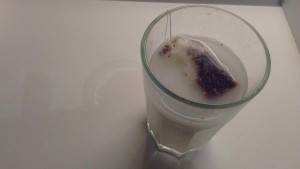
This is so horrible I can hardly bear to write about it. But I feel it is my duty. To expose the culprit of this crime would be unfair. It would like pointing a finger at someone in public and articulating their perversions. Note the half-filled glass, the water which is too cold to let the tea infuse, the milk that was added immediately (to ‘Darjeeling’ which can hardly cope with milk in any case!), the paper teabag floating like a discarded wrapper in a milky slew. And what’s inside the bag? The ‘dust’ resembles something I found once when cleaning out the bottom of my compost bin. Perhaps it’s better, after all, it never infused. I don’t know what it tasted like; I didn’t drink it. But plenty of people in Berlin do: day after f-ing day here.
*
Where does this leave us? In the end, what most determined a good cup of tea was the quality of tea used. But the sad truth is that until consumers demand better, most tea in Berlin will remain low-quality bagged dust. Often it is packaged as something fine, distinguished. But the worst bag I experienced was like cleaning the attic with my tongue (and I didn’t even try Number 5!). As a starting precaution one should never order tea if it’s in a bag that’s not ‘pyramidal’ or Muslin (Kusmi, for example). Otherwise, don’t ruin your palate or your stomach or your day.
All this means, more than ever, when I am actually presented with a good cup of tea in the German capital my thankfulness is unbounded. You can do us all a favour by thanking profusely those who get tea right. Maybe then the message will spread.
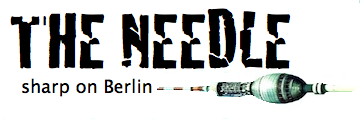
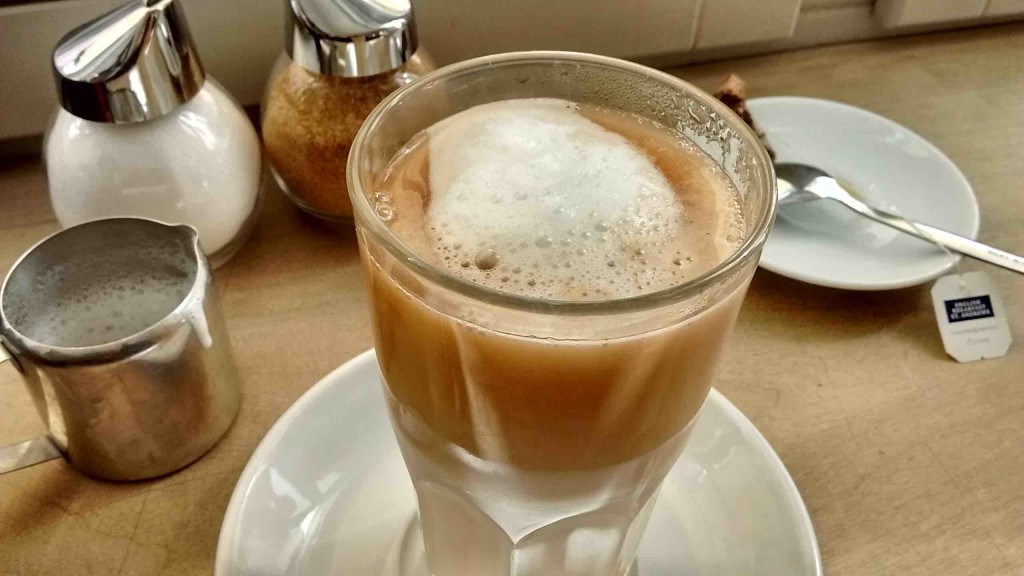
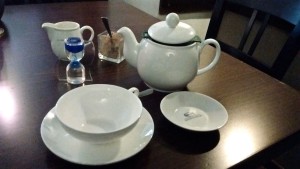
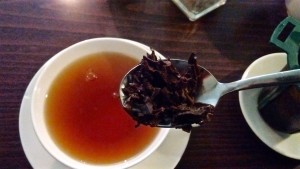
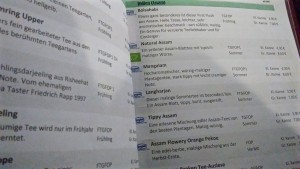
One thought on “Bad Tea in Berlin (Part Two)”